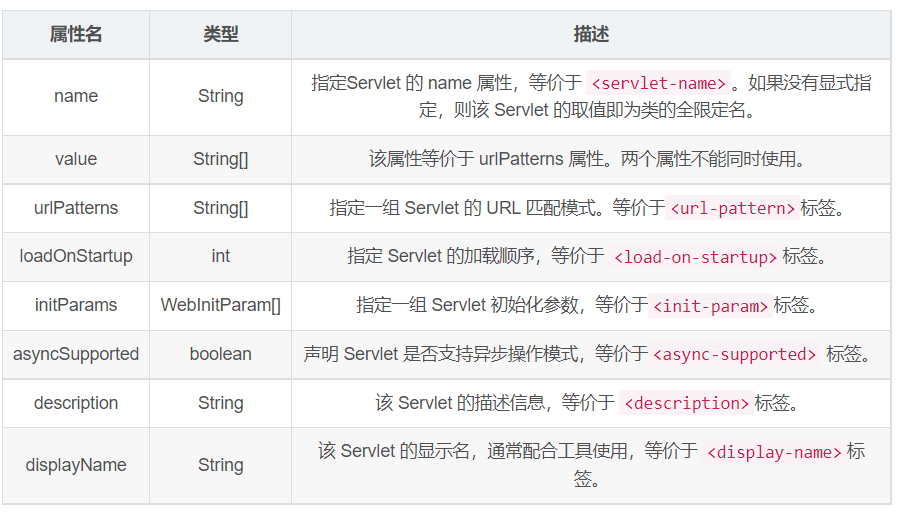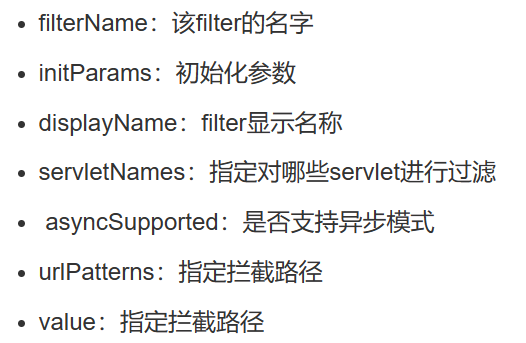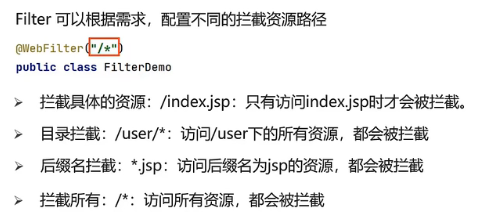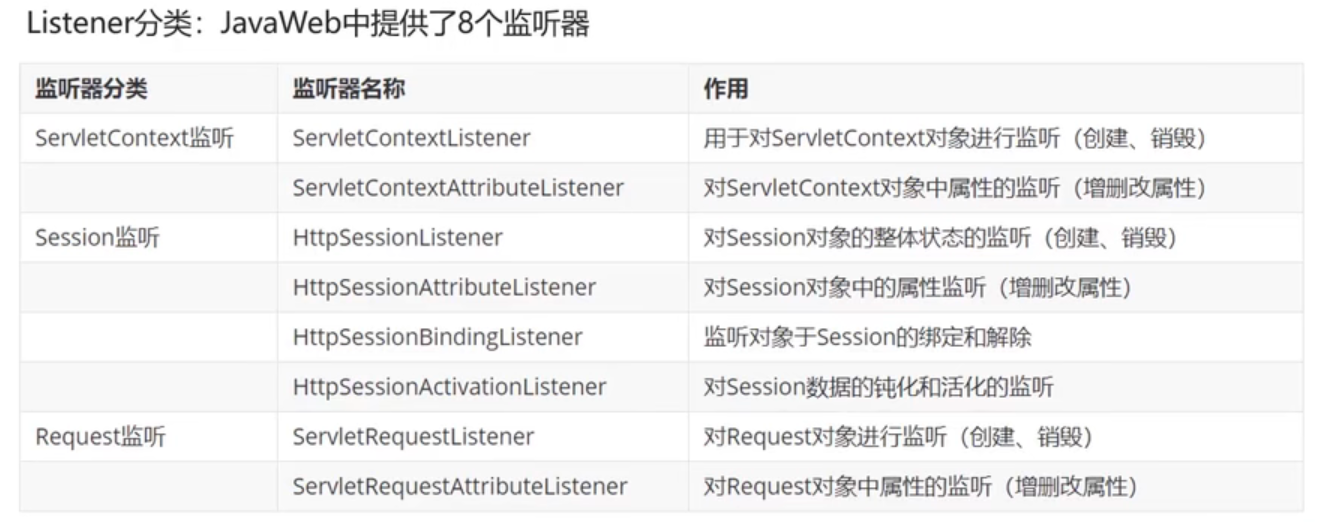javaweb
学习文档:https://blog.csdn.net/qq_36188127/article/details/109370717
学习视频:https://www.bilibili.com/video/BV12J411M7Sj
实训项目:https://gitee.com/xinyu-yudian/easybuy
网站访问流程:
1.输入一个域名,回车,
2.检查本机的C:\Windows\System32\driveretc\hosts配置文件下有没有这个域名映射
a.有:直接返回对应的ip地址,在这个地址中有需要访问的web程序,可以直接访问
b.没有:去DNS服务器找,找到的话返回,找不到就会返回404
HTTP
http默认端口号80
https默认端口号443
Servlet
B/S -> Browser 浏览器 , Server 服务器
生命周期
@WebServlet("/logreg") public class LogRegServlet extends HttpServlet { public void init() { // 初始化代码... } public void service(ServletRequest req, ServletResponse resp) throws ServletException, IOException{ } public void doGet(HttpServletRequest req, HttpServletResponse resp)throws ServletException,IOException { // Servlet 代码 } public void doPost(HttpServletRequest req,HttpServletResponse resp)throws ServletException, IOException { // Servlet 代码 } public void destroy() { // 终止化代码... } }
HttpServlet
jsp请求路径
${pageContext.request.contextPath}
HttpServletRequest - 请求
req.setCharacterEncoding("utf-8");
//通过请求转发的方式实现页面跳转 req.setAttribute("list",list);//给jsp页面传值 req.getAttribute("list");//jsp页面获取值 req.removegetAttribute("list"); //删除添加的属性 request.getRequestDispatcher("跳转页面").forward(req,resp);
getParameter(表单中的name):您可以调用 request.getParameter() 方法来获取表单参数的值
getParameterValues(表单中的name):数组
getParameterNames():如果您想要得到当前请求中的所有参数的完整列表,则调用该方法
HttpServletResponse - 重定向
resp.setCharacterEncoding("utf-8"); resp.setContentType("text/html;charset=utf-8");
//通过重定向的方式实现页面跳转 response.sendRedirect("check.jsp");
sendRedirect()传中文乱码
msg = URLEncoder.encode(msg, "UTF-8")
ServletContext - servlet容器,代表整个servlet应用
1.获取 //request对象 ServletContext cont = request.getServletContext(); //httpServlet获取 ServletContext cont = this.getServletContext() 2.功能 //获取MIME类型(在互联网通信过程中定义的一种文件数据类型, 格式:(大类型/小类型)text/html - image/png) String mime = cont.getMimeType(String file); //域对象-共享数据 setAttribute("list",list); getAttribute("list"); removegetAttribute("list"); //获取文件的服务器路径 cont.getRealPath("/文件名");
web.xml
@WebServlet("") //对应虚拟路径
<!--真实路径-->
<servlet>
<servlet-name>serlet名</servlet-name>
<servlet-class>Servlet类所在路径</servlet-class>
</servlet>
<!--虚拟路径-->
<servlet-mapping>
<servlet-name>serlet名</servlet-name>
<url-pattern>/url访问路径</url-pattern>
</servlet-mapping>
变量
<!-- 全局变量-->
<context-param>
<param-name>name</param-name>
<param-value>张三</param-value>
</context-param>
//获取xml配置的全局变量
getServletContext().getInitParameter("name");
//设置局部变量--放在指定真实路径下 <init-param> <param-name>pwd</param-name> <param-value>123456</param-value> </init-param> //获取局部参数 getInitParameter("pwd");
注解

起始页面设置
<welcome-file-list>
<welcome-file>index.jsp</welcome-file>
</welcome-file-list>
功能
cookie - 客户端储存技术
cookie大小4kb - >4kb浏览器不识别
一个web可发送20个
一个浏览器保存300个
1.创建Cookie对象,设置数据 Cookie cookie = new Cookie("key","name"); 2.发送Cookie到发客户端,使用response对象 response.addCookie(cookie); 3.获取客户端所带有Cookie,使用request对象 Cookie[] cookies = request.getCookies(); 4.遍历数组,获取每一个Cookie对象,for 5.使用Cookie对象方法获取数据 cookie.getName(); cookie.getValue();
1. 默认情况下,cookie数据保存到内存里,当浏览器关闭后,Cookie数据被销毁
2. 持久化存储:
setMaxAge(int seconds)
1. 正数:将Cookie数据写到硬盘的文件中,持久化存储。并指定cookie存活时间,时间到后,cookie文件自动失效。
2. 负数:默认值-1,即关闭浏览器后,cookie即失效
3. 零:删除cookie信息-立即
设置中文 msg = URLEncoder.encode(msg,"utf-8");
//页面获取Cookie - 只可储存字符串 ${cookie.key.value} - key指存储在cookie中的键名称
cookie.setDomain("");//设置在某个域名下生效 设置cookie可使用路径:cookie.setPath("/");
session - 服务端储存技术
1、用户第一次请求浏览器,将信息登陆到浏览器:
当浏览器发送请求到服务器的时候,tomcat发现是一个全新的请求,会在tomcat内存中开辟新的一块内存,并给它一个新的sessionId作为标记。servlet调用setAttrition中设置session的名字--键值,比如name = 张三就被保存下来,tomcat将生成的sessionId返回给浏览器,浏览器会把这个sessionID值存储到Cookie中,只要Cookie在有效期内,sessionId就会随着请求发送给服务器。
2、用户第二次请求浏览器:
当浏览器第二次发送请求给服务器的时候带有一个第一次记录的sessionId ,tomcat服务器通过存储的sessionID,就知道了浏览器存储的sessionId对应数据存储的区域,调用request.getsession()的时候,获取sessionID对应的数据,将数据取出来返回给服务器。达到用户自动登陆的目的。
1.获取Session对象 HttpSession session = request.getSession(); 2.Session对象功能 void setAttribute(String name,object o); 存储数据到session中 Object getAttribute(String name); 根据key,获取值 void removeAttribute(String name); 根据key,珊瑚键值对 a.钝化 当服务器正常关闭时,还存活着的session(在设置时间内没有销毁) 会随着服务器的关闭被以文件(“SESSIONS.ser”)的形式存储在tomcat 的work 目录下,这个过程叫做Session 的钝化。 b.活化 当服务器再次正常开启时,服务器会找到之前的“SESSIONS.ser” 文件, 从中恢复之前保存起来的Session 对象,这个过程叫做Session的活化。 c.销毁 maven: <session-config> <session-timeout>30</session-timeout> </session-config> //以秒为单位,即在没有活动30分钟后,session将失效 session.setMaxInactiveInterval(30*60); //立即销毁 session.invalidate();
setPath(java.lang.String uri) 设置路径【】 setDomain(java.lang.String pattern) 设置域名 , 一般无效,有浏览器自动设置,setDomain(".hr.com")
如果浏览器设置禁用了Cookie,那么Session就不能用了,可以采用URL重写

Fliter(过滤器)
@WebFilter(filterName = "filter" ,urlPatterns = "/*") public class LifeCycleFilter implements Filter { //初始化阶段:当服务器启动时,我们的服务器(Tomcat)就会读取配置文件,扫描注解,然后来创建我们的Filter。 @Override public void init(FilterConfig filterConfig) throws ServletException { } //拦截和过滤阶段:只要请求资源的路径和拦截的路径相同,那么过滤器就会对请求进行过滤,这个阶段在服务器运行过程中会一直循环。 @Override public void doFilter(ServletRequest servletRequest, ServletResponse servletResponse, FilterChain filterChain) throws IOException, ServletException { //放行 chain.doFilter(req, resp); } //销毁阶段:当服务器(Tomcat)关闭时,服务器创建的Filter也会随之销毁。 @Override public void destroy() { } }


Listener(监听器)


分页
limit 起始下标,页面大小
起始下标 = (当前页-1)*页面大小 -> index = (curPage-1)*pageSize
总页数=总条数%页面大小==0 ? 总条数/页面大小 :总条数/页面大小+1 -> pages=totals%pageSize==0 ? totals/pageSize : totals%pageSize+1
文件上传/下载
上传
@MultipartConfig //如果是文件上传,必须要设置该注解! //设置请求的编码格式 req.setCharacterEncoding("UTF-8"); //获取Part对象 (Servlet 将 mutipart/form-data 的 POST 请求封装成 Part对象) Part part = req.getPart("myfile"); //通过Part对象得到上传的文件名 String fileName = part.getSubmittedFileName(); //得到文件存放的路径 String filePath = req.getServletContext().getRealPath("/"); System.out.println("文件存放路径:" + filePath); //上传文件到指定目录 part.write(filePath + "/" + fileName);
示例
private Product fileUpLoad(HttpServletRequest req, HttpServletResponse resp){ //1.判断是否包含文件上传功能 boolean flag = ServletFileUpload.isMultipartContent(req); if (flag) { //2.获得项目发布之后的绝对路径 String realPath = req.getServletContext().getRealPath("temp"); //3.disk,申请一块空间 DiskFileItemFactory disk = new DiskFileItemFactory(1024 * 10, new File(realPath)); //4.把刚才的空间做文件上传用 ServletFileUpload fileUpload = new ServletFileUpload(disk); //5.解析用户的请求:提交过来的表单 Product product = new Product(); int id = 0; try { List<FileItem> fileItems = fileUpload.parseRequest(req); if (fileItems != null && fileItems.size() > 0) { //循环判断 for (FileItem f : fileItems) { //文件表单 if (f.isFormField()){ //得到name String fieldName = f.getFieldName(); //得到对应的值 String value = f.getString("UTF-8"); if("id".equals(fieldName)){ product.setId(Integer.parseInt(value)); id = Integer.parseInt(value); } }else { String fieldName = f.getFieldName(); String value = f.getString("UTF-8"); if ("fileName".equals(fieldName)) { String fileName = ""; if (value != null && !"".equals(value)){ //文件上传的控件处理 fileName = UUID.randomUUID().toString().replace("-", "").toUpperCase() + ".jpg"; //上传到哪里 String path = req.getServletContext().getRealPath("files") + "/" + fileName; System.out.println("--------------------------------------------------"); System.out.println("上传图片:"+path); f.write(new File(path)); }else { Product idPro = new Product(); idPro.setId(id); List<Product> prol = proService.selPro(idPro,1,1); if (prol!=null && prol.size()>0) { fileName = prol.get(0).getFileName(); } } //保存到实体book product.setFileName(fileName); //删除 f.delete(); } } } } return product; } catch (FileUploadException e) { e.printStackTrace(); } catch (Exception e) { e.printStackTrace(); } } return null; }
下载
示例
<!-- 浏览器能够识别的资源--> <a href="images/hello.text">文本文件</a> <a href="images/a.jpg">图片文件</a> <!-- 浏览器不能够识别的资源--> <a href="images/zzz.rar">压缩文件</a> <hr> <!-- 点击,浏览器直接下载--> <a href="images/hello.text" download>文本文件</a> <a href="images/a.jpg" download="test.png">图片文件</a>
//设置请求编码格式 req.setCharacterEncoding("UTF-8"); resp.setContentType("text/html;charset=UTF-8"); //获取参数 (得到要下载的文件名) String fileName = req.getParameter("fileName"); //参数的非空判断 trim:去除字符串的前后空格 if(fileName == null || "".equals(fileName.trim())){ resp.getWriter().write("请输入要下载的文件名!"); resp.getWriter().close(); return; } //得到图片存放的路径 String Path = req.getServletContext().getRealPath("/images/"); //通过路径得到file对象 File file = new File(Path+fileName); System.out.println(file.getPath()); //判断文件对象是否存在并且是否为标准文件 if(file.exists() && file.isFile()){ //设置响应类型(浏览器无法使用某种方式或激活某个程序来处理的MIME类型) resp.setContentType("application/octet-stream"); //设置响应头信息 resp.setHeader("Content-Disposition","attachment;filename=" + fileName); //得到file文件的输入流 InputStream in = new FileInputStream(file); //得到字节输出流 ServletOutputStream out = resp.getOutputStream(); //定义byte数组 byte[] bytes = new byte[1024]; //定义长度 int len =0; //循环输出 while((len = in.read(bytes))!= -1){ //输出 out.write(bytes,0,len); } //关闭资源 out.close(); in.close(); }else{ resp.getWriter().write("文件不存在,请重试!"); resp.getWriter().close(); }
导出EXCEL
servlet
@WebServlet("/excel") public class ExcelServlet extends HttpServlet { @Override protected void doGet(HttpServletRequest req, HttpServletResponse resp) throws ServletException, IOException { doPost(req, resp); } @Override protected void doPost(HttpServletRequest req, HttpServletResponse resp) throws ServletException, IOException { req.setCharacterEncoding("UTF-8"); resp.setContentType("text/html;charset=UTF-8"); resp.setCharacterEncoding("UTF-8"); String go = req.getParameter("go"); switch (go){ case "user": excelUser(req,resp); break; } } private void excelUser(HttpServletRequest req, HttpServletResponse resp){ try { UserService userService = new UserServiceImpl(); //根据手机号,查询数据库中需要导出的数据 int total = userService.total(null); List<User> userList = userService.selUser(null,1,total); //创建excel表头 List<String> column = new ArrayList<>(); column.add("序号"); column.add("登录名"); column.add("用户名"); column.add("密码"); column.add("性别"); column.add("身份证"); column.add("邮箱"); column.add("电话"); column.add("身份"); //表头对应的数据 List<Map<String,Object>> data = new ArrayList<>(); //遍历获取到的需要导出的数据,k要和表头一样 for (int i = 0; i < userList.size(); i++) { Map<String,Object> dataMap = new HashMap<>(); User user = userList.get(i); dataMap.put(column.get(0),user.getId()); dataMap.put(column.get(1),user.getLoginName()); dataMap.put(column.get(2),user.getUserName()); dataMap.put(column.get(3),user.getPassword()); dataMap.put(column.get(4),user.getSex()); dataMap.put(column.get(5),user.getIdentityCode()); dataMap.put(column.get(6),user.getEmail()); dataMap.put(column.get(7),user.getMobile()); dataMap.put(column.get(8),user.getType()); data.add(dataMap); } //调用导出工具类 ExportExcel.exportExcel("用户信息表",column,data,req,resp); }catch (Exception e){ e.printStackTrace(); } } }
工具类
public class ExportExcel { /** * @param sheetName 工作表的名字 * @param column 列名 * @param data 需要导出的数据 ( map的键定义为列的名字 一定要和column中的列明保持一致 ) * @param response */ public static void exportExcel(String sheetName, List<String> column, List<Map<String,Object>> data, HttpServletRequest request, HttpServletResponse response){ //创建工作薄 HSSFWorkbook hssfWorkbook = new HSSFWorkbook(); //创建sheet HSSFSheet sheet = hssfWorkbook.createSheet(sheetName); // 表头 HSSFRow headRow = sheet.createRow(0); for (int i = 0; i < column.size(); i++){ headRow.createCell(i).setCellValue(column.get(i)); } for (int i = 0; i < data.size(); i++) { HSSFRow dataRow = sheet.createRow(sheet.getLastRowNum() + 1); for (int x = 0; x < column.size(); x++) { dataRow.createCell(x).setCellValue(data.get(i).get(column.get(x))==null?"":data.get(i).get(column.get(x)).toString()); } } response.setContentType("application/vnd.ms-excel"); try { //获取浏览器名称 String agent=request.getHeader("user-agent"); String filename=sheetName+".xls"; //不同浏览器需要对文件名做特殊处理 if (agent.contains("Firefox")) { // 火狐浏览器 filename = "=?UTF-8?B?" + new BASE64Encoder().encode(filename.getBytes("utf-8")) + "?="; filename = filename.replaceAll("\r\n", ""); } else { // IE及其他浏览器 filename = URLEncoder.encode(filename, "utf-8"); filename = filename.replace("+"," "); } //推送浏览器 response.setHeader("Content-Disposition","attachment;filename="+filename); hssfWorkbook.write(response.getOutputStream()); } catch (Exception e) { e.printStackTrace(); } } }
MD5加密
public class MD5 { // 加盐位置 public static int[] salts = { 3, 8, 16, 22, 25 }; public static String md5(String str) throws NoSuchAlgorithmException { MessageDigest md5 = MessageDigest.getInstance("MD5"); byte[] srcBytes = str.getBytes(StandardCharsets.UTF_8); md5.update(srcBytes); byte[] resultBytes = md5.digest(); //转为16进制 String result = ""; for(byte b : resultBytes) { String temp = Integer.toHexString(b & 0xff); if(temp.length() == 1) { temp = "0" + temp; } result = result + temp; } return result; } // 加盐方法 public static String addSalt(String md5Str) { StringBuffer sb = new StringBuffer(md5Str); for (int n = salts.length - 1; n >= 0; n--) { int r = (int) (Math.random() * 10); // 插入随机数 sb.insert(salts[n], r); } return sb.toString(); } // 去盐方法 public static String delSalt(String md5Str) { StringBuffer sb = new StringBuffer(md5Str); for (int n = 0; n < salts.length; n++) { sb.deleteCharAt(salts[n]); } return sb.toString(); } public static void main(String[] args) { try { String pwd = MD5.md5("123456"); System.out.println("加盐前"+pwd); String slatPwd = addSalt(pwd); System.out.println("加盐后"+slatPwd); String delPwd = delSalt(slatPwd); System.out.println("解盐后"+delPwd); } catch (NoSuchAlgorithmException e) { throw new RuntimeException(e); } } }
JWT
public class JWTUtils { //设置密钥 private static final String SECRET = "xinyu"; //获取token public static String getToken(User user){ //创建集合用于装接收的数据 Map<String,Object> claims = new HashMap<>(); claims.put("loginName",user.getLoginName()); claims.put("type",user.getType()); //创建jwt对象 JwtBuilder jwtBuilder = Jwts.builder(); //签发算法,设置密钥 jwtBuilder.signWith(SignatureAlgorithm.HS512,SECRET); //添加数据 jwtBuilder.setClaims(claims); //设置签发时间 jwtBuilder.setIssuedAt(new Date(System.currentTimeMillis())); //设置过期时间-5秒 // jwtBuilder.setExpiration(new Date(System.currentTimeMillis() + 1000*5)); Calendar calendar=Calendar.getInstance(); calendar.add(Calendar.MINUTE,30); //操作分钟+1 jwtBuilder.setExpiration(calendar.getTime()); //设置签发人 jwtBuilder.setSubject(SECRET); //生成token return jwtBuilder.compact(); } //解析token public static Claims parseToken(String token){ Claims claims = null; try{ claims = (Claims)Jwts.parser() .setSigningKey(SECRET) .parse(token).getBody(); }catch (UnsupportedJwtException e){ e.printStackTrace(); System.out.println("不支持JWT"); } catch (MalformedJwtException e){ e.printStackTrace(); System.out.println("无效的JWT"); } catch (SignatureException e){ e.printStackTrace(); System.out.println("签名无效"); }catch (ExpiredJwtException e){ e.printStackTrace(); System.out.println("token已过期"); }catch (IllegalArgumentException e){ e.printStackTrace(); System.out.println("token为null"); }catch (Exception e){ e.printStackTrace(); System.out.println("解析失败"); } return claims; } public static int getType(Claims claims){ return (int)claims.get("type"); } public static void main(String[] args) { User user = new User(); user.setLoginName("John"); user.setType(1); String token = JWTUtils.getToken(user); System.out.println(token); Claims claims = JWTUtils.parseToken(token); System.out.println(getType(claims)); } }
图片验证码
public class Code { public static final String VERIFY_CODES = "123456789ABCDEFGHIJKLMNOPQRSTUVWXYZ"; private static Random random = new Random(); public static void main(String[] args) throws Exception { //调用主方法,在D盘产生名为a的验证码图片,并在服务端打印验证码内容 OutputStream fos=new FileOutputStream("d://a.jpg"); String s = Code.outputVerifyImage(100, 50, fos, 4); System.out.println(s); //此为CheckCodeServlet写入,在jsp中可直接调用 // 如:“<img id="checkCodeImg" src="/brand-demo/CheckCodeServlet">” //ServletOutputStream os = response.getOutputStream(); //String s = CheckCodeUtil.outputVerifyImage(100, 50, os, 4); } /** * 输出随机验证码图片流,并返回验证码值(一般传入输出流,响应response页面端,Web项目用的较多) * * @param width 图片宽度 * @param height 图片高度 * @param os 输出流 * @param verifySize 数据长度 * @return 验证码数据 * @throws IOException */ public static String outputVerifyImage(int width, int height, OutputStream os, int verifySize) throws IOException { String verifyCode = generateVerifyCode(verifySize); outputImage(width, height, os, verifyCode); return verifyCode; } /** * 使用系统默认字符源生成验证码 * * @param verifySize 验证码长度 * @return */ public static String generateVerifyCode(int verifySize) { return generateVerifyCode(verifySize, VERIFY_CODES); } /** * 使用指定源生成验证码 * * @param verifySize 验证码长度 * @param sources 验证码字符源 * @return */ public static String generateVerifyCode(int verifySize, String sources) { // 未设定展示源的字码,赋默认值大写字母+数字 if (sources == null || sources.length() == 0) { sources = VERIFY_CODES; } int codesLen = sources.length(); Random rand = new Random(System.currentTimeMillis()); StringBuilder verifyCode = new StringBuilder(verifySize); for (int i = 0; i < verifySize; i++) { verifyCode.append(sources.charAt(rand.nextInt(codesLen - 1))); } return verifyCode.toString(); } /** * 生成随机验证码文件,并返回验证码值 (生成图片形式,用的较少) * * @param w * @param h * @param outputFile * @param verifySize * @return * @throws IOException */ public static String outputVerifyImage(int w, int h, File outputFile, int verifySize) throws IOException { String verifyCode = generateVerifyCode(verifySize); outputImage(w, h, outputFile, verifyCode); return verifyCode; } /** * 生成指定验证码图像文件 * * @param w * @param h * @param outputFile * @param code * @throws IOException */ public static void outputImage(int w, int h, File outputFile, String code) throws IOException { if (outputFile == null) { return; } File dir = outputFile.getParentFile(); //文件不存在 if (!dir.exists()) { //创建 dir.mkdirs(); } try { outputFile.createNewFile(); FileOutputStream fos = new FileOutputStream(outputFile); outputImage(w, h, fos, code); fos.close(); } catch (IOException e) { throw e; } } /** * 输出指定验证码图片流 * * @param w * @param h * @param os * @param code * @throws IOException */ public static void outputImage(int w, int h, OutputStream os, String code) throws IOException { int verifySize = code.length(); BufferedImage image = new BufferedImage(w, h, BufferedImage.TYPE_INT_RGB); Random rand = new Random(); Graphics2D g2 = image.createGraphics(); g2.setRenderingHint(RenderingHints.KEY_ANTIALIASING, RenderingHints.VALUE_ANTIALIAS_ON); // 创建颜色集合,使用java.awt包下的类 Color[] colors = new Color[5]; Color[] colorSpaces = new Color[]{Color.WHITE, Color.CYAN, Color.GRAY, Color.LIGHT_GRAY, Color.MAGENTA, Color.ORANGE, Color.PINK, Color.YELLOW}; float[] fractions = new float[colors.length]; for (int i = 0; i < colors.length; i++) { colors[i] = colorSpaces[rand.nextInt(colorSpaces.length)]; fractions[i] = rand.nextFloat(); } Arrays.sort(fractions); // 设置边框色 g2.setColor(Color.GRAY); g2.fillRect(0, 0, w, h); Color c = getRandColor(200, 250); // 设置背景色 g2.setColor(c); g2.fillRect(0, 2, w, h - 4); // 绘制干扰线 Random random = new Random(); // 设置线条的颜色 g2.setColor(getRandColor(160, 200)); for (int i = 0; i < 20; i++) { int x = random.nextInt(w - 1); int y = random.nextInt(h - 1); int xl = random.nextInt(6) + 1; int yl = random.nextInt(12) + 1; g2.drawLine(x, y, x + xl + 40, y + yl + 20); } // 添加噪点 // 噪声率 float yawpRate = 0.05f; int area = (int) (yawpRate * w * h); for (int i = 0; i < area; i++) { int x = random.nextInt(w); int y = random.nextInt(h); // 获取随机颜色 int rgb = getRandomIntColor(); image.setRGB(x, y, rgb); } // 添加图片扭曲 shear(g2, w, h, c); g2.setColor(getRandColor(100, 160)); int fontSize = h - 4; Font font = new Font("Algerian", Font.ITALIC, fontSize); g2.setFont(font); char[] chars = code.toCharArray(); for (int i = 0; i < verifySize; i++) { AffineTransform affine = new AffineTransform(); affine.setToRotation(Math.PI / 4 * rand.nextDouble() * (rand.nextBoolean() ? 1 : -1), (w / verifySize) * i + fontSize / 2, h / 2); g2.setTransform(affine); g2.drawChars(chars, i, 1, ((w - 10) / verifySize) * i + 5, h / 2 + fontSize / 2 - 10); } g2.dispose(); ImageIO.write(image, "jpg", os); } /** * 随机颜色 * * @param fc * @param bc * @return */ private static Color getRandColor(int fc, int bc) { if (fc > 255) { fc = 255; } if (bc > 255) { bc = 255; } int r = fc + random.nextInt(bc - fc); int g = fc + random.nextInt(bc - fc); int b = fc + random.nextInt(bc - fc); return new Color(r, g, b); } private static int getRandomIntColor() { int[] rgb = getRandomRgb(); int color = 0; for (int c : rgb) { color = color << 8; color = color | c; } return color; } private static int[] getRandomRgb() { int[] rgb = new int[3]; for (int i = 0; i < 3; i++) { rgb[i] = random.nextInt(255); } return rgb; } private static void shear(Graphics g, int w1, int h1, Color color) { shearX(g, w1, h1, color); shearY(g, w1, h1, color); } private static void shearX(Graphics g, int w1, int h1, Color color) { int period = random.nextInt(2); boolean borderGap = true; int frames = 1; int phase = random.nextInt(2); for (int i = 0; i < h1; i++) { double d = (double) (period >> 1) * Math.sin((double) i / (double) period + (6.2831853071795862D * (double) phase) / (double) frames); g.copyArea(0, i, w1, 1, (int) d, 0); if (borderGap) { g.setColor(color); g.drawLine((int) d, i, 0, i); g.drawLine((int) d + w1, i, w1, i); } } } private static void shearY(Graphics g, int w1, int h1, Color color) { int period = random.nextInt(40) + 10; // 50; boolean borderGap = true; int frames = 20; int phase = 7; for (int i = 0; i < w1; i++) { double d = (double) (period >> 1) * Math.sin((double) i / (double) period + (6.2831853071795862D * (double) phase) / (double) frames); g.copyArea(i, 0, 1, h1, 0, (int) d); if (borderGap) { g.setColor(color); g.drawLine(i, (int) d, i, 0); g.drawLine(i, (int) d + h1, i, h1); } } } }



 浙公网安备 33010602011771号
浙公网安备 33010602011771号